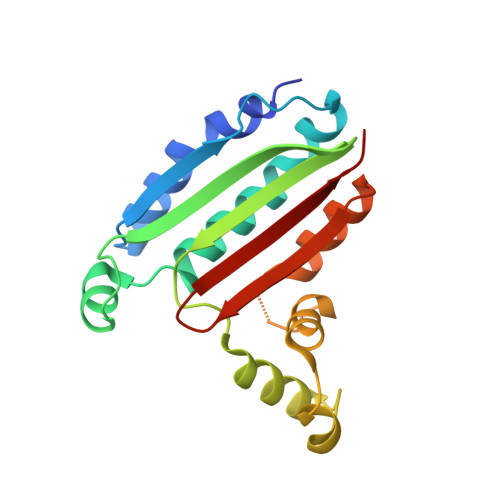Repurposing Hsp90 inhibitors as antimicrobials targeting two-component systems identifies compounds leading to loss of bacterial membrane integrity.
Fernandez-Ciruelos, B., Albanese, M., Adhav, A., Solomin, V., Ritchie-Martinez, A., Taverne, F., Velikova, N., Jirgensons, A., Marina, A., Finn, P.W., Wells, J.M.(2024) Microbiol Spectr 12: e0014624-e0014624
- PubMed: 38917423
- DOI: https://doi.org/10.1128/spectrum.00146-24
- Primary Citation of Related Structures:
8PF2 - PubMed Abstract:
The discovery of antimicrobials with novel mechanisms of action is crucial to tackle the foreseen global health crisis due to antimicrobial resistance. Bacterial two-component signaling systems (TCSs) are attractive targets for the discovery of novel antibacterial agents. TCS-encoding genes are found in all bacterial genomes and typically consist of a sensor histidine kinase (HK) and a response regulator. Due to the conserved Bergerat fold in the ATP-binding domain of the TCS HK and the human chaperone Hsp90, there has been much interest in repurposing inhibitors of Hsp90 as antibacterial compounds. In this study, we explore the chemical space of the known Hsp90 inhibitor scaffold 3,4-diphenylpyrazole (DPP), building on previous literature to further understand their potential for HK inhibition. Six DPP analogs inhibited HK autophosphorylation in vitro and had good antimicrobial activity against Gram-positive bacteria. However, mechanistic studies showed that their antimicrobial activity was related to damage of bacterial membranes. In addition, DPP analogs were cytotoxic to human embryonic kidney cell lines and induced the cell arrest phenotype shown for other Hsp90 inhibitors. We conclude that these DPP structures can be further optimized as specific disruptors of bacterial membranes providing binding to Hsp90 and cytotoxicity are lowered. Moreover, the X-ray crystal structure of resorcinol, a substructure of the DPP derivatives, bound to the HK CheA represents a promising starting point for the fragment-based design of novel HK inhibitors. The discovery of novel antimicrobials is of paramount importance in tackling the imminent global health crisis of antimicrobial resistance. The discovery of novel antimicrobials with novel mechanisms of actions, e.g., targeting bacterial two-component signaling systems, is crucial to bypass existing resistance mechanisms and stimulate pharmaceutical innovations. Here, we explore the possible repurposing of compounds developed in cancer research as inhibitors of two-component systems and investigate their off-target effects such as bacterial membrane disruption and toxicity. These results highlight compounds that are promising for further development of novel bacterial membrane disruptors and two-component system inhibitors.
Organizational Affiliation:
Host-Microbe Interactomics Group, Dept. Animal Sciences, Wageningen University & Research (WUR), Wageningen, the Netherlands.















